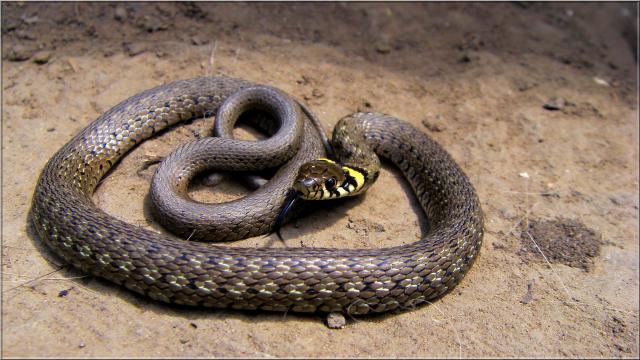Scientific classification:
Kingdom: Animalia
Phylum: Chordata
Subphylum: Vertebrata
Class: Reptilia
Order: Squamata
Suborder: Serpentes
Family: Colubridae
The grass snake (Natrix natrix), sometimes called the ringed snake or water snake is a European nonvenomous snake. It is often found near water and feeds almost exclusively on amphibians.
Description
Closeup of a 1 metre (3 ft 3 in) grass snake from Great Britain
The grass snake is typically dark green or brown in colour with a characteristic yellow collar behind the head, which explains the alternative name ringed snake. The colour may also range from grey to black, with darker colours being more prevalent in colder regions, presumably owing to the thermal benefits of being dark in colour. The underside is whitish with irregular blocks of black, which are useful in recognizing individuals. In Great Britain the grass snake is the largest reptile, reaching up to 190 centimetres (6 ft 3 in) total length, though such large specimens are rare. Females are considerably larger than males, typically reaching a size of 90–110 centimetres (2 ft 11 in–3 ft 7 in) when fully grown. Males are approximately 20 centimetres (8 in) shorter and significantly smaller in girth. Weight is about 240 grams (8 oz). Since the colour of its collar is often pale yellow to white in the Balkans region, the name for this snake in Serbian/Croatian language is belouška/bjelouška, which means "white-eared snake".
Distribution
This species is one of only three snakes to occur in Great Britain, and is distributed throughout lowland areas of England and Wales; it is almost absent from Scotland and is not found in Ireland, which has no native snakes. It is widely distributed in mainland Europe, ranging from mid Scandinavia to southern Italy. It is also found in northwestern Africa. British grass snakes belong to the subspecies N. n. helvetica, but experts differ on the number of subspecies.
Feeding
They prey almost entirely on amphibians, especially the common toad and the common frog, although they may also occasionally eat mammals and fish. Captive snakes have been observed taking earthworms offered by hand, but dead prey items are never taken. The snake will search actively for prey, often on the edges of water, using sight and sense of smell (using the Jacobson's organ). They consume prey live without using constriction.
Habitat
Grass snakes are strong swimmers and may be found close to fresh water, although there is evidence that individual snakes often do not make use of water bodies throughout the entire season.
The preferred habitat appears to be open woodland and "edge" habitat such as field margins and woodland borders as these may offer adequate refuge while still affording ample opportunity for thermoregulation through basking. Pond edges are also favoured and the relatively high chance of observing this secretive species in such areas may account for their perceived association with ponds and water.
Grass snakes, as with most reptiles, are at the mercy of the thermal environment and need to overwinter in areas which are not subject to freezing. Thus they typically spend the winter underground where the temperature is relatively stable.
Reproduction
As spring approaches, the males emerge first and spend much of the day basking in an effort to raise body temperature and thereby metabolism. This may be a tactic to maximise sperm production as the males mate with the females as soon as they emerge up to 2 weeks later in April or earlier if environmental temperatures are favourable. The leathery-skinned eggs are laid in batches of 8–40 in June to July and hatch after about 10 weeks. To survive and hatch the eggs require a temperature of at least 21 °C (70 °F), but preferably 28 °C (82 °F), with high humidity. Rotting vegetation such as compost heaps are preferred locations. The young are about 18 centimetres (7 in) long when they hatch and are immediately independent.
Migration
After breeding in summer, snakes tend to hunt and may range widely during this time, moving up to several hundred metres in a day. Prey items tend to be large compared to the size of the snake and this impairs the movement ability of the snake. Snakes which have recently eaten rarely move any significant distance and will stay in one location, basking to optimize their body temperature until the prey item has been digested. Individual snakes may only need two or three significant prey items throughout an entire season.
Ecdysis (moulting)
Ecdysis occurs at least once during the active season. As the outer skin wears and the snake grows, the skin loosens from the body, including from the eyes, which may turn a milky white colour at this time. This presumably affects the eyesight of the snake and they do not move or hunt during this time. The outer skin is eventually sloughed in one piece (inside-out) and normal movement activity is resumed.
Defence
Not being venomous, the snake's only defence is to produce a garlic-smelling fluid from the anal glands, or to feign death by becoming completely limp. They may also perform an aggressive display in defence, hissing and striking without actually opening the mouth. They rarely bite in defence. It is claimed that they may also secrete blood from the mouth and nose whilst playing dead.
Protection and threats
The species has various predator species, including corvids, storks, owls and perhaps other birds of prey, foxes and the domestic cat. In England, grass snakes are protected under the Wildlife and Countryside Act 1981 and cannot be harmed or traded without a licence, although they may legally be captured and kept in captivity.
Two of the subspecies are considered critically endangered: N. n. cetti (Sardinian grass snake) and N. n. schweizeri. In 2007, the grass snake was included on the updated UK Biodiversity Action Plan as a species in need of conservation and greater protection.
http://www.freeweb.hu/hobbiallat/cikkek/hullo65.htm
http://hu.wikipedia.org/wiki/V%C3%ADzisikl%C3%B3
Alfred Edmund Brehm: Az állatok világa - Légrády testvérek (1905)
http://www.mme.hu/khvszweb/index.php?option=com_content&view=article&id=88%3Avizisiklo-natrix-natrix&catid=49%3Ahazai-huellk&Itemid=90&lang=en
